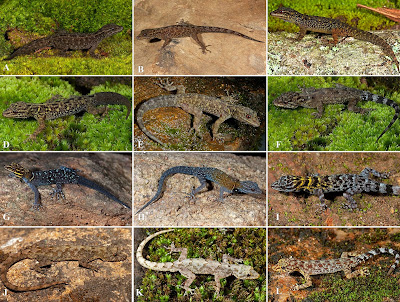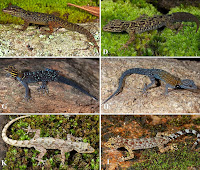 |
| Coloration in life of all 12 holotypes; A: Cnemaspis balerion sp. nov.; B: C. lithophilis sp. nov.; C: C. rubraoculus sp. nov.; D: C. nimbus sp. nov.; E: C. wallaceii sp. nov.; F: C. smaug sp. nov.; G: C. regalis sp. nov.; H: C. galaxia sp. nov.; I: C. nigriventris sp. nov.; J: C. flavigularis sp. nov.; K: C. palanica sp. nov.; L: C. jackieii sp. nov.. Pal, Mirza, Dsouza & Shanker, 2021 Photos by Saunak Pal. facebook.com/SaunakPal |
Abstract
The highly speciose gekkonid genus Cnemaspis Strauch, 1887 is polyphyletic, with three distantly related and geographically isolated clades from Africa, South Asia (SA), and Southeast Asia. At present, there are 85 known species within SA Cnemaspis, although the number continues to increase rapidly with focused surveys and rigorous taxonomic work. Recent studies have provided valuable insights into the diversity and evolutionary history of SA Cnemaspis; however, most of these studies lack sufficient sampling in the Western Ghats (WG), where the genus has its greatest diversity. We addressed this research gap by conducting extensive sampling across the WG and re-examining museum specimens, thus providing a systematic account of various extant Cnemaspis species along with their distribution and natural history. We described 12 new species and a southern WG endemic clade of SA Cnemaspis. Ten of the newly described species are endemic to the forests of the southern WG. We also identified 10 well-supported subclades that can be separated across morphological, geographic, and phylogenetic axes. Time-calibrated phylogeny and ancestral area reconstructions confirmed the Paleocene origin of SA Cnemaspis in the WG and provide insights into its evolutionary history and biogeography. The discovery of multiple endemic and deeply divergent lineages further highlights the evolutionary significance of the WG for lizards.
Keywords: Biogeography, Cnemaspis, Dwarf geckos, Molecular phylogeny, New species, Osteology, South Asia, Systematics, Western Ghats
I. wynadensis clade:
Comprising nine known lineages viz. C. kolhapurensis; C. sisparensis (Theobald, 1876); C. kottiyoorensis Cyriac & Umesh, 2014; C. heteropholis Bauer, 2002; C. anaikattiensis Mukherjee, Bhupathy & Nixon 2005; C. wynadensis; C. chengodumalaensis Cyriac, Palot, Deuti & Umesh, 2020; C. zacharyi Cyriac, Palot, Deuti & Umesh, 2020; and C. magnifica Khandekar, Thackeray, Pal & Agarwal, 2020. We identified two new well-supported, distantly related lineages with moderate support, described here as Cnemaspis balerion sp. nov. and Cnemaspis lithophilis sp. nov. (Figure 3).
Cnemaspis balerion sp. nov.
Etymology: The species is named after “Balerion”, a famous dragon from George R. R. Martin’s
epic fantasy novel series, ‘A song of Ice and fire’. The dragon was also known as ‘the black dread’
due to presence of black scales. Like Balerion, this new species shows the presence of distinct
clusters of black scales forming spots on the dorsum.
Suggested common name: Balerion forest gecko.
Cnemaspis lithophilis sp. nov.
Etymology: The species epithet is derived from the combination of the Greek word ‘lithos’
meaning stone and ‘philia’ meaning fondness, due to the close association of this species with
rocks.
Suggested common name: Sharavati rock gecko.
II. beddomei clade:
Comprising six known lineages viz. C. beddomei; C. aaronbaueri Sayyed, Grismer, Campbell & Dileepkumar, 2019; C. anamudiensis Cyriac, Johny, Umesh & Palot, 2018; C. maculicollis Cyriac, Johny, Umesh & Palot, 2018; C. ornata (Beddome, 1870); and C. nairi Inger, Marx & Koshy, 1984. Seven of the newly identified lineages belong to this clade (Figure 2), described here as Cnemaspis rubraoculus sp. nov., Cnemaspis wallaceii sp. nov., Cnemaspis nimbus sp. nov., Cnemaspis smaug sp. nov., Cnemaspis nigriventris sp. nov., Cnemaspis galaxia sp. nov., and Cnemaspis regalis sp. nov. (Figure 3).
Cnemaspis rubraoculus sp. nov.
Etymology: The species epithet is derived by combining the Latin word ‘rubrum’, meaning red,
and ‘oculus’ meaning eye; referring to the prominent red iris.
Suggested common name: Ruby eyed forest gecko.
Cnemaspis nimbus sp. nov.
Etymology: The species epithet is derived from the Latin word ‘nimbus’ meaning cloud; referring
to the prominent clouded pattern on the dorsum and flank.
Suggested common name: Clouded forest gecko.
Cnemaspis wallaceii sp. nov.
Etymology: The species epithet is a patronym, honouring Alfred Russel Wallace for his
tremendous contribution to the field of biogeography. His work has been an inspiration for the
authors and towards this study.
Suggested common name: Wallace’s forest gecko.
Cnemaspis smaug sp. nov.
Etymology: The species is named after “Smaug”, the dragon from J. R. R. Tolkien's 1937 novel,
‘The Hobbit’. The name is derived from the old German verb ‘smeuganan’ meaning “to creep” or
“to squeeze through a hole”. The type specimens of this species were found within crevices of
rocks and boulders inside the forest. Additionally, like dragons, the dorsum is armoured with large
conical tubercles.
Suggested common name: Smaug forest gecko
Cnemaspis regalis sp. nov.
Etymology: The species epithet is based on the Latin word ‘regalis’ meaning kingly or royal, due
to the head ornamented with golden yellow crown like pattern in the males of this species.
Suggested common name: Golden crowned day gecko or Royal day gecko.
Cnemaspis galaxia sp. nov.
Etymology: The species epithet is derived from the word ‘galaxy’ due to the dorsum colouration
with the sun’s haze like yellow on the anterior and bluish white star like spots on a black
background towards the posterior end, in the male of this species.
Suggested common name: Galaxy day gecko.
Cnemaspis nigriventris sp. nov.
Etymology: The species epithet is derived from the combination of Latin word ‘niger’ meaning
black and ‘venter’ meaning belly, due to the distinct black ventral colouration in the male of this
species.
Suggested common name: Black-bellied day gecko.
III. littoralis clade:
Comprising two known lineages from the WG, including C. littoralis and the recently described C. palakkadensis Sayyed, Cyriac & Dileepkumar, 2020. Two new lineages belong to this clade, described here as Cnemaspis flavigularis sp. nov., and Cnemaspis palanica sp. nov. (Figure 3). This clade includes members of the C. podihuna clade from Sri Lanka, as observed in other recent studies (Agarwal et al., 2020b; Khandekar et al., 2019a).
Cnemaspis flavigularis sp. nov.
Etymology: The species epithet is derived from the combination of the Latin word ‘flavus’
meaning yellow and ‘gularis’ meaning throat, referring to the distinct yellow colouration of the
throat in males of the new species.
Suggested common name: Yellow throated day gecko.
Cnemaspis palanica sp. nov.
Etymology: The species epithet refers to the ‘Palani Hills’ in the SWG of Tamil Nadu, from where
this species is described.
Suggested common name: Palani Hills day gecko.
IV. indica clade:
Comprising three known lineages viz. C. indica; C. nilagirica Manamendra-Arachchi, Batuwita & Pethiyagoda, 2007; and C. anandani Murthy, Nitesh, Sengupta & Deepak, 2019.
V. bangara clade:
Comprising three known lineages viz. C. bangara; C. graniticola Agarwal, Thackeray, Pal & Khandekar, 2020; and C. yelagiriensis Agarwal, Thackeray, Pal & Khandekar, 2020.
VI. girii clade:
Comprising seven known lineages viz. C. girii; C. mahabali Sayyed, Pyron & Dileepkumar, 2018; C. limayei Sayyed, Pyron & Dileepkumar, 2018; C. ajijae Sayyed, Pyron & Dileepkumar, 2018; C. flaviventralis Sayyed, Pyron & Dahanukar, 2016; C. amba Khandekar, Thackeray & Agarwal, 2019; and C. koynaensis Khandekar, Thackeray & Agarwal, 2019.
VII. goaensis clade:
Comprising two known lineages viz. C. amboliensis Sayyed, Pyron & Dileepkumar, 2018 and C. goaensis.
VIII. mysoriensis clade:
Comprising seven known lineages viz. C. mysoriensis (Jerdon, 1853); C. otai Das & Bauer, 2000; C. yercaudensis Das & Bauer, 2000; C. adii Srinivasulu, Kumar & Srinivasulu, 2015; C. avasabinae Agarwal, Bauer & Khandekar 2020; C. rishivalleyensis Agarwal, Thackeray & Khandekar 2020; and C. stellapulvis Khandekar, Thackeray & Agarwal, 2020.
IX. gracilis clade:
Comprising four known lineages viz. C. gracilis; C. agarwali Khandekar, 2019; C. shevaroyensis Khandekar, Gaitonde & Agarwal, 2019; and C. thackerayi Khandekar, Gaitonde & Agarwal, 2019. A well-supported new lineage is described here as Cnemaspis jackieii sp. nov. (Figure 3).
 |
| Cnemaspis jackieii sp. nov. E. female paratype [CESL 193], F. Habitat at type locality in Vairavankulam Reserve Forest, Tamil Nadu, G. communal egg deposition in used potter wasp nests. |
Cnemaspis jackieii sp. nov.
Etymology: The species epithet is a patronym as a tribute to the famous actor and martial artist
Jackie Chan. The new species was found to be very fast and moved rapidly on rock boulders,
sneaking into the smallest crevices to escape when approached, reminiscent of the stunts of Jackie
Chan. His many screen characters as an explorer and adventurer have been an inspiration for the
authors.
Suggested common name: Jackie’s day gecko.
X. monticola clade:
Comprising two known lineages viz. C. monticola and C. australis from the WG. This clade also includes members of the C. kandiana clade from Sri Lanka and Southeast Asian representatives of SA Cnemaspis, as observed in other recent studies (Agarwal et al., 2020b; Khandekar et al., 2019a).
CONCLUSIONS:
Despite being one of the world’s “hottest biodiversity hotspots”, the WG have undergone substantial habitat loss and degradation due to changes in land-use patterns (Jha et al., 2000; Myers et al., 2000; Reddy et al., 2013). It has been suggested that significant parts of the WG will be urbanized by 2030 due to population expansion and development (Seto et al., 2012). The recent discoveries of new evolutionarily distinct lineages from the WG highlight the biogeographic and evolutionary significance of this region as well as the importance of sampling strategies to detect endemic lineages while conducting broad-level phylogenetic studies (Britz et al., 2020; Chaitanya et al., 2019; Dinesh et al., 2020; Mallik et al., 2019; Pal et al., 2018; Robin et al., 2017; Vijayakumar et al., 2019). The recognition of 10 new morphologically distinct and geographically isolated species of Cnemaspis from the SWG also highlights our lack of knowledge regarding the immense diversity of this region and its potential to harbor more unknown species. Recent discoveries of species that are morphologically similar to extant species within their respective clades (e.g., C. palakkadensis and C. littoralis; C. nilagirica and C. anandani, C. nairi and Cnemaspis nigriventris sp. nov.) further emphasize the potential for unexplored cryptic diversity in the WG. Most of the recently described evolutionarily distinct lineages, as well as those identified in this study, are range-restricted and have very specific microhabitat requirements. It is important to identify these unique habitats within the landscape and focus efforts on the conservation of unique lineages with diverse evolutionary histories.
In the last decade, there has been a surge in the discovery of new species of Cnemaspis from peninsular India, especially from regions not known to harbor high Cnemaspis diversity, such as the southern edge of the Mysore Plateau and the NWG. The molecular data generated in this study not only include new species, but also species previously known only from type localities or specimens, and thus provide a baseline for future taxonomic research. The discovery of a highly diverse SWG endemic clade (Clade II) and a dry zone granite-associated clade (Agarwal et al., 2020b) suggest that more effort is required to elucidate the diversity within SA Cnemaspis. Additionally, our findings stress the importance of spatial sampling and geographical distribution of species, along with molecular, phylogenetic, and morphological methods, in uncovering deeply divergent lineages.
Saunak Pal, Zeeshan A. Mirza, Princia Dsouza and Kartik Shanker. 2021. Diversifying on the Ark: Multiple New Endemic Lineages of Dwarf Geckos from the Western Ghats provide insights into the Systematics and Biogeography of South Asian Cnemaspis (Reptilia: Squamata). Zoological Research. 42(6); 675-691. DOI: 10.24272/j.issn.2095-8137.2021.074










